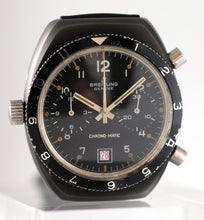
Breitling, Genève, "Chrono-Matic", Ref. 2114. Circa 1969. tonneau-shaped, selfwinding, PVD steel wristwatch with left-handed crown, round-button chronograph, registers, date and outer graduated bezel.
Case: Brushed Tonneau case in stainless with black PVD like coating. case with screw on back and calibrated bezel.
Dial: Black with tritium-coated indexes, hours, auxiliary dials for the 12-hour and 30-minute registers, inner minutes/seconds division. Tritium-coated baton hands. and red date
Movement: Caliber 12, rhodium-plated, 17 jewels, straight-line lever escapement, monometallic balance, shock absorber, self-compensating blued steel flat balance spring, micro-rotor housed within the movement.
Diameter: 38mm Thickness: 14mm
Circa: 1969
More about Breitling:
By the 1960s, many brands had begun the attempt to create an automatic chronograph movement. Two main groups were competing to develop this first – Movado/Zenith, and Heuer/Breitling/Hamilton/Dubois Depraz. Since both groups exhibited their new automatic chronograph wristwatches at Basel in 1969, both claimed to be the first. There is still debate today as to which group can claim the title of producing the first automatic chronograph, but it is accepted that since the Chrono-matic was the first to be available to the public for purchase, it wins the title.
In 1965, the group of Heuer, Breitling, Hamilton, and Dubois Depraz began working on the project, dubbed “Project 99”, with each company being responsible for a part of the final watch. In 1967, a patent was filed for the caliber 11, and in 1968 the first prototypes were developed. In September of 1968, Breitling manufactured the first Chrono-matic wristwatch.
The design of the caliber 11 in the Chrono-matic was interesting in that it required the winding crown to be located on the opposite side of the chronograph pushers, by 9 o’clock. Since the watch had an automatic movement and would not need to be wound by hand as much, it was decided by the four firms that moving the crown to the opposite side was best.
The present watch, with a PVD like coating 2114 is one of the first watch to be receiving a black metal treatment on its stainless steel case. The Heuer Monaco Dark Lord will be introduced much later in the mid 1970's. These Breitling looked extremely modern for their period with a "2001 Space Odyssey" influence but were a huge market failure. It seems that very few were made and of the few that were sold only a handful survived because of the unreliable black coating. Our watch is still in remarkable shape for a watch which is nearly 50 years old and one of a handful known to exist. An extremely rare watch at an affordable price




















